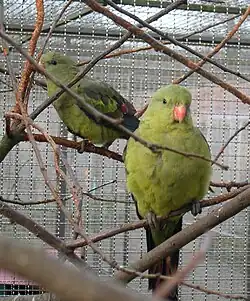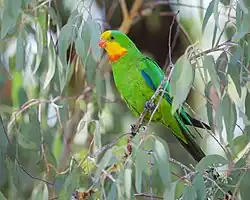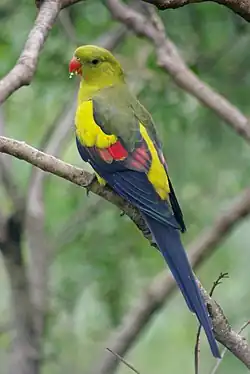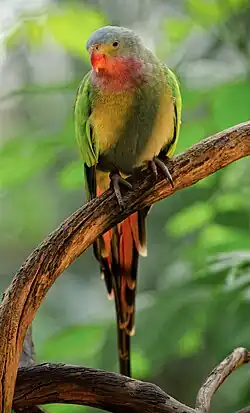Polytelis
| Polytelis | |
|---|---|

| |
| Regent parrots, Polytelis anthopeplus | |
| Scientific classification | |
| Kingdom: | Animalia |
| Phylum: | Chordata |
| Class: | Aves |
| Order: | Psittaciformes |
| Family: | Psittaculidae |
| Tribe: | Polytelini |
| Genus: | Wagler, 1832 |
| Type species | |
| Psittacus barrabandi[1] Swainson, 1821
| |
| Species | |
|
Polytelis alexandrae | |
The genus Polytelis (literally translates into 'magnificent') of the family Psittaculidae consists of three species long-tailed parrot endemic to Australia. Traditionally, it was included in the Australian broad-tailed parrots (tribe Platycercini),[2] but molecular studies place the genus within the Polytelini.
A 2017 molecular study placed the regent parrot as an early offshoot to the genus Asprosmictus and not as closely related to the other two species.[3]
Taxonomy
The genus has three species.[4]
| Common name | Scientific name and subspecies | Range | Size and ecology | IUCN status and estimated population |
|---|---|---|---|---|
| Superb parrot
|
Polytelis swainsonii (Desmarest, 1826) |
New South Wales and Victoria. | Size: Habitat: Diet: |
LC
|
| Regent parrot
|
Polytelis anthopeplus (Lear, 1831) Two subspecies
|
southern Australia. | Size: Habitat: Diet: |
LC
|
| Princess parrot or Princess Of Wales (POW) parakeet
|
Polytelis alexandrae Gould, 1863 |
Australia | Size: Habitat: Diet: |
NT
|
References
- ^ "Psittaculidae". aviansystematics.org. The Trust for Avian Systematics. Retrieved 2023-07-24.
- ^ Forshaw, Joseph M.; Cooper, William T. (1981) [1973, 1978]. Parrots of the World (corrected second ed.). David & Charles, Newton Abbot, London. ISBN 0-7153-7698-5.
- ^ Provost, Kaiya L.; Joseph, Leo; Smith, Brian Tilston (2018). "Resolving a phylogenetic hypothesis for parrots: Implications from systematics to conservation". Emu - Austral Ornithology. 118 (1): 7–21. Bibcode:2018EmuAO.118....7P. doi:10.1080/01584197.2017.1387030. S2CID 52995298.
- ^ "Zoological Nomenclature Resource: Psittaciformes (Version 9.020)". www.zoonomen.net. 2009-03-05. Archived from the original on 2018-12-25. Retrieved 2009-03-19.


